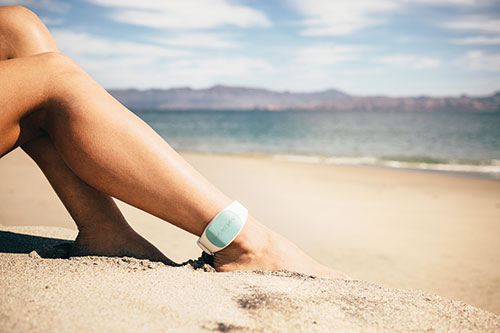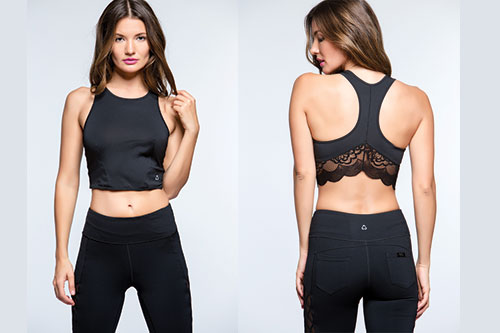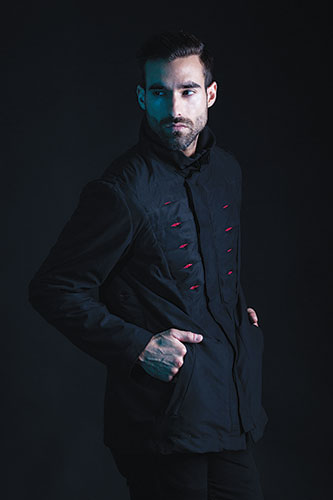July 17, 2017
Cool Wearable Tech for Hot Summer Days
In the summer months, it’s all about the cool factor, both in temperature and temperament. And there are a range of wearable technologies meant to help with both senses of the word. Robotic jackets and synthetic fabrics engineered using nanotechnology are being developed to help people control their body temperature. Smart bikinis and other wearable devices keep sunbathers abreast of harmful UV exposure. There are wristbands that promise to prevent your beach trip from becoming the next Jaws sequel. Even sunglasses, perhaps the ultimate accessories in the quest for cool, are doing double duty with versions that allow the wearer to take videos, make payments and more.

First up, let’s look at that robo-jacket. Gustavo Cadena, CEO and CTO of Omius Inc., was spurred by the inconvenience of shedding layers in places like packed subways when he created the Omius Jacket. Rather than have to take off a jacket or sweater, why not create a garment that adjusts to whatever conditions you’re in? The jacket is inspired by nature – specifically the microscopic holes, or stomata, on leaves, which plants open and close to regulate their temperature. Small vents on the jacket’s torso can be opened and closed, via robotic mechanisms, to match weather conditions. “It’s a very interesting sensation,” Cadena says. “It’s kind of like being able to change from one piece of clothing to another in a second.”
The jacket is also designed with an “intelligent system” that will learn from the wearer’s comfort preferences, and automatically meet them, when the same parameters occur during future uses, Cadena says. “More use and feedback allows the jacket to adapt to different cases,” he adds.
Target markets for the jacket include motorcyclists and winter athletes. Omius has done some prototypes and testing of its robotic jacket, but hasn’t worked out all the kinks of mass manufacturing. Cadena says the product could go into production by the end of the year, and bear a similar cost to other premium jackets on the market. “It’s complex, but it could be a game-changer in the industry,” he adds.
Researchers at Stanford University are working on a new type of plastic-based textile that can cool the body more efficiently than the natural and synthetic fabrics currently available. The researchers blended nanotechnology, photonics and chemistry to give polyethylene – otherwise known as kitchen cling wrap – characteristics desirable in clothing. The modified polyethylene allows thermal radiation, air and water vapor to pass through and is opaque to visible light. A high percentage of a person’s body heat is dissipated as infrared radiation, according to Shanhui Fan, one of the researchers, but there hasn’t been much research into designing textiles that let that radiation freely pass, thus helping to cool the body. “In hindsight, some of what we’ve done looks very simple, but it’s because few have really been looking at engineering the radiation characteristics of textiles,” adds Fan, an electrical engineering professor who specializes in the study of visible and invisible light.
Another textile that focuses on the thermal radiation generated by the body is Celliant. Instead of allowing heat to pass through the fabric, miniaturized ceramic disks in the yarn emit infrared energy back into the body. Seth Casden, CEO of Celliant, says this can help increase blood flow and aid performance and recovery. “We’ve created a hybrid engine for the human body,” he says. “Ours is a very elegant, simple use of naturally occurring minerals, and they’re being harnessed to use the body’s own heat and emissions and return that energy as a benefit back to the person.”
For a lot of people, Casden says, wearing Celliant fabric “creates a cooling sensation” because it pulls heat from the skin. Plus, he adds, the extra energy poured back into the body helps it achieve homeostasis and makes it better able to regulate temperature. Celliant technology is used in a number of products, including pajamas, yoga wear, wetsuits, running gear and even mattresses and sheets.
Just about everyone knows it’s important to limit sun exposure, but how many people remember to reapply sunscreen regularly? It’s a serious issue, when you consider the statistic that about one in five people will get skin cancer in their lifetime. Several tech firms are looking at ways apparel and wearable devices can be used to help people monitor UV rays. At the Consumer Electronics Show (CES) in Vegas this year, Spinali Designs, a French company, showed off an array of swimsuits equipped with UV sensors that indicate when to reapply sunscreen. The year before, makeup company L’Oréal teamed up with electronics company MC10 to unveil My UV Patch, a stretchable skin sensor designed to monitor UV exposure. The patch contains photosensitive dyes that factor baseline skin tone and change color based on the level of sun exposure.
Another company with a similar goal is Ultra Inc., which has developed the Violet app and the Violet Plus, a quarter-sized waterproof device that can be worn as a wristband or clipped onto clothing to monitor UV exposure and vitamin D levels. “It actually takes your particular physiology and says, ‘here’s how long you need to be out in the sun,’” says Liz Garnand, vice president of marketing at Ultra.
The device is expected to cost $99 once it begins production. Right now, however, Ultra is still trying to raise the money for a pilot launch of 200 devices, says CEO Jona Donaldson. Once that initial batch rolls out, and Ultra does quality assurance and gets feedback from early adopters, the company is ready to go “whole hog” with production, he adds. In addition to selling its own device, Ultra hopes to work with other companies. Ultra has already received inquiries from a swimwear firm that wants to use its technology in a bathing suit line as well as researchers interested in using it in clinical studies, Garnand says.
Nathan Garrison grew up near the ocean, surfing from a young age. When he was in high school, however, his best friend got attacked by a bull shark while hitting the waves. “The whole concept of being bitten by a shark became a reality,” Garrison says. “I always thought about it after that.”
Eventually, that uncomfortable awareness led him to sit down with his father to try to come up with a solution to reduce the risk of shark attacks for ocean aficionados. The result was Sharkbanz, a wristband that uses powerful magnets to generate an electromagnetic field and disrupt the electrical sense sharks use to navigate murky waters. “It’s a really unpleasant situation for them,” Garrison explains. “Imagine you’re in a dark room and feeling around and your pupils are dilated and someone shines a super-bright flashlight on you. You’d want to turn away. It’s kind of like that.”
The $69 device started shipping in 2015 and the company has already racked up dozens of positive testimonials. Of course, the device doesn’t work in every situation: Last year, a teen in Florida was bitten by a blacktip shark while wearing one of the bands. That situation, according to Garrison, was the rarest type of shark attack, where the teen jumped off his surfboard and essentially landed on the shark. The band is designed to repel the more typical hit-and-run type attacks, where a shark “takes an investigative bite out of things” to see if they’re food, he adds. “We’re not selling a magic blanket or some force field,” Garrison says. “We’re always super-honest and open about what the benefits are.”
Last year, social media company Snap, maker of the trendy Snapchat messaging app, made a splash with Spectacles, whimsical sunglasses capable of recording short videos and beaming them back to the wearer’s phone. The hype around those $130 shades seems to have spurred a renewed interest in smart eyewear, which had previously been mocked during the short-lived Google Glass era.
At South by Southwest (SXSW), Visa unveiled a prototype for payment-enabled sunglasses, according to CNBC. Users would link payment information to the glasses, then remove them and tap the tiny chip on their side to an NFC-enabled payment terminal. “It ties back to our tagline of everywhere you want to be,” Chris Curtin, chief brand and innovation marketing officer at Visa, told CNBC. The sunglasses aren’t available to the public, but Visa is testing demand or whether any brands are interested in sponsoring the product.
Connected eyewear maker Vuzix is working on the Blade 3000 Smart Sunglasses, which will include a full-color heads-up display, so the wearer can access things like GPS directions, weather information, restaurant menus and more, without picking up a second screen. The wireless device will run on the Android platform and include an integrated HD camera, head-motion tracker, touchpad, haptic vibration feedback and built-in noise-cancelling mics with speech recognition. Tech website Tom’s Guide called the Blade “non-doofus AR glasses” that consumers might actually be interested in wearing. The smart shades are expected to be released sometime this year.
Photo Gallery

The Violet Plus wearable from Ultra tracks your UV exposure as well as your vitamin D levels.

The Vuzix Blade 3000 Smart Sunglasses will include a heads-up display so the wearer can access GPS map directions and other information without checking a phone.

The maker of Sharkbanz says the product can reduce the risk of shark attacks for surfers and other ocean enthusiasts.

Celliant textiles are used in athletic clothing, like this yoga apparel from Titika Activewear.

The Omius Jacket uses robotics to open and close vents along the torso, adjusting to the wearer’s environment.
THERESA HEGEL is the executive editor of Wearables. Contact: thegel@asicentral.com; follow her on Twitter at @TheresaHegel.

Product Hub
Find the latest in quality products, must-know trends and fresh ideas for upcoming end-buyer campaigns.